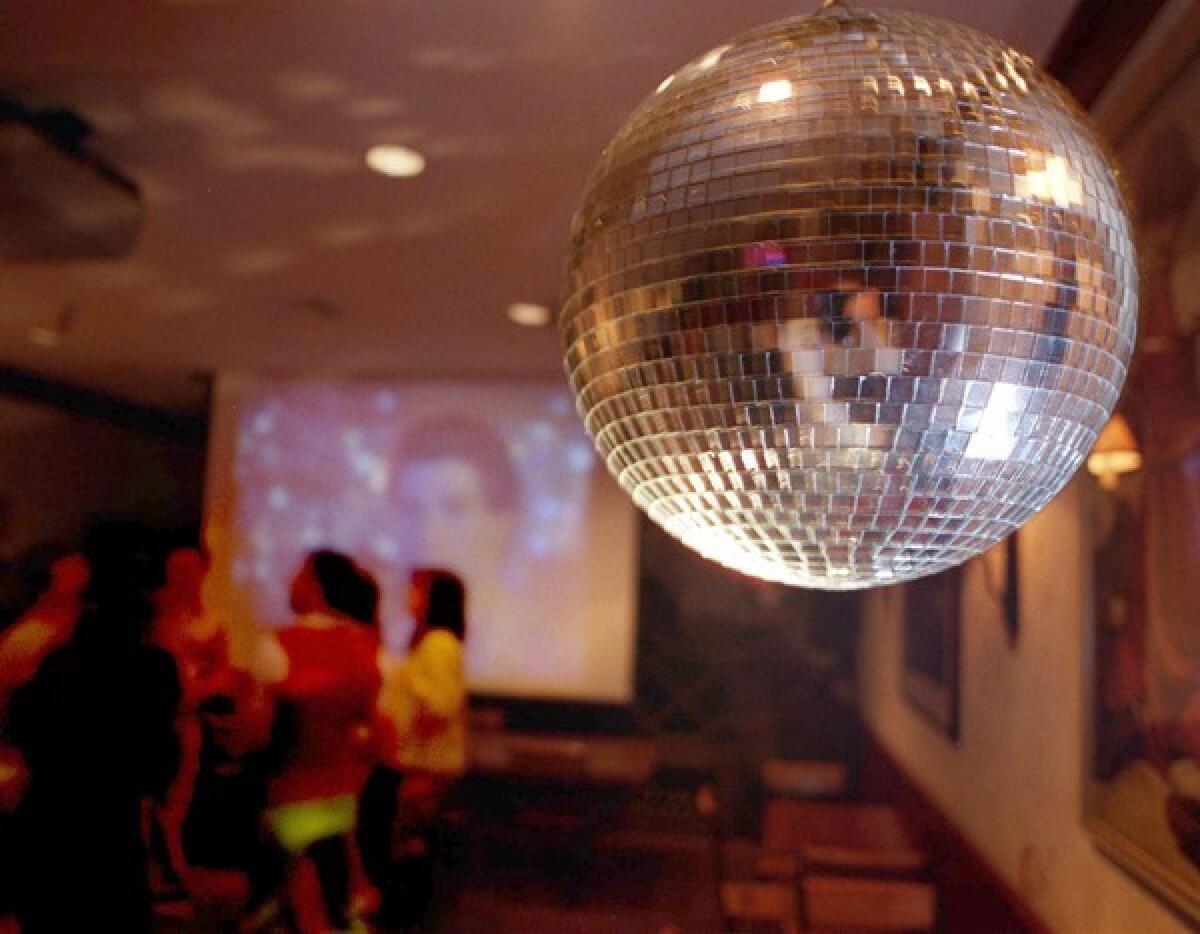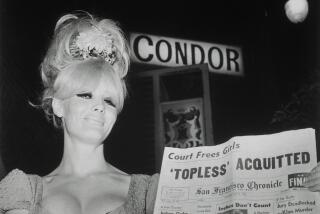‘Hot Stuff: Disco and the Remaking of American Culture’ by Alice Echols

Hot Stuff
Disco and the Remaking
of American Culture
Alice Echols
W.W. Norton: 338 pp., $26.95
Recently, I attended a wedding reception during which a 10-year-old boy, to entertain the adults on the dance floor, started making the point-to-the-sky motion that John Travolta patented in 1977’s “Saturday Night Fever.” Why was I surprised? I doubt the tiny dancer even saw the movie, but he needn’t have. Thirty years after its heyday, disco has so thoroughly saturated global popular culture that its songs and signifiers are recognizable to children born in a different century.
The death of disco was quick and dramatic. In April 1979, Newsweek ran a cover story on “The Disco Takeover”; less than a year later, radio had placed a “virtual ban” on the music. It’s arguable that disco is known as much for its downfall as for its peak years. But as Alice Echols explains in “Hot Stuff,” a quietly dazzling history of the musical genre that she describes as “interpretive rather than . . . comprehensive,” disco’s brief life as a mainstream phenomenon yielded a rich, seemingly never-ending afterlife. Disco begat new wave, early hip-hop and a lineage of pop stars that includes Madonna, Prince, Michael Jackson and Lady Gaga, who has performed in a dress made up of disco ball shards. Disco has become, in the words of critic Jon Pareles, “roots music.”
Echols, a professor at Rutgers University and the author of a biography of Janis Joplin, is interested in the way that disco culture acted as a staging ground for the sexual revolution of the 1970s and empowered African Americans, women and gays -- the cultural “Other” who were its primary makers and its initial consumers -- usually with mixed blessings. In the late 1970s and early ‘80s, Echols deejayed at a small Ann Arbor club and was charged by dancing’s “collective yielding to the rhythmic.” “Hot Stuff” is the result of a lifetime of thinking deeply about the music and its influence.
From the beginning, disco music was dogged by critics as schmaltzy, repetitive and not authentically black. The songs grew out of 1960s soul, but the typical disco single, writes Echols, favored “the synthetic over the organic, the cut-up over the whole, the producer over the artist.” Barry White, who crooned about “fidelity, devotion, and desire” backed by a mixed-race orchestra of sweeping strings, and Isaac Hayes, who covered Burt Bacharach, were seen by detractors as soft, apolitical, bending to bourgeois tastes -- a wrong direction from the “trouble music” of Sly Stone and Marvin Gaye and the hard male swagger of James Brown. But White and Hayes, says Echols, “weren’t interested in cataloging disappointments, but rather in breaking expected racial stereotypes and ‘taking it to the bank.’ ”
Echols selects some of the genre’s best-known black female vocalists to illustrate their ambivalent relationships to the music and their public images. Chaka Khan, a former Black Panther, wore midriff-baring outfits and strutted onstage, promising to “sure ‘nuff set your stuff on fire” but came to regret her sex symbol status. Donna Summer became disco’s biggest star after recording “Love to Love You Baby” and “I Feel Love,” porny moaning set to chilly Teutonic beats.
When Summer later experimented with rock -- music that didn’t conform to “racially coded” genres -- her career stalled. Patti LaBelle, Nona Hendryx and Sarah Dash had once made up a standard-issue girl group called the Bluebelles; they threw caution to the wind and reinvented themselves as freaky glam stars, making albums (rather than singles) of forthright political songs and embracing their gay following. They had one monster hit, “Lady Marmalade,” but later singles went nowhere.
Were women able to claim power with disco, as some critics have argued -- was it a “cultural arm of feminism”? The truth, as Echols explains, was more complicated. Disco songs often put female desire front and center -- “you can ring my bell” -- and allowed black women to play up a sexuality they were once encouraged to hide. But for many, sexual expressiveness was “deeply unsettling,” Echols writes.
The group that formed disco’s most loyal fan base was gay men. When the Firehouse, the first New York gay disco, opened in 1971, two years after the Stonewall riots, it revolutionized the way gays mingled -- until only recently, same-sex dancing had been forbidden, even at gay bars, whose owners were wary of police raids. Fueled by drugs and DJ mixes that were carefully constructed to build and climax, discos allowed gay men to experience “tribal oneness” dancing in a sea of shirtless bodies. Many gay men began to sculpt their bodies for dancing, and the muscled, short-haired “clone” look became the norm -- out went the Playbill-collecting sissies of yore. Meanwhile, the gay community carried on a complicated dance with the straight mainstream.
When gay clubs became trendy among heterosexuals, many entrepreneurs opened invitation-only clubs, catering almost exclusively to white, gay richies. The Village People, a band that adopted the new macho image, became massively popular and distanced itself in the media from its beginnings in the gay underground. (The general public was so clueless about the band’s gay-sex references that the Navy came close to using footage of the band’s “In the Navy” video for recruitment commercials.) Gay discos continued to thrive into the 1980s, long after the mainstream had stopped listening, but AIDS soon decimated the dance-floor population.
Echols gives a thorough, fascinating account of the making of “Saturday Night Fever,” which was based on a magazine article about a Bay Ridge, Brooklyn, disco. The story, written by Nik Cohn, turned out to have been largely fabricated. But the movie’s screenwriter, Norman Wexler, worked up a complex portrait of an ambitious working-class kid who finds escape through dance-floor stardom. It’s a dead end, though -- this celebration of disco, writes Echols, “suggests that getting ahead . . . requires abandoning disco.” The shrill Bee Gees songs that made up the movie’s soundtrack soon flooded the airwaves and were for many the stake in disco’s heart. Two years later, in 1979, the ugly, thuggish backlash against disco climaxed in a riot at Chicago’s Comiskey Park after a radio station blew up a crate of records and thousands of people rushed the field. Some historians have long suggested that homophobia and racism were masked as hatred toward disco.
Echols, always even-handed, writes that the music was beginning to falter anyway. Disco died, a character quips on the early 1980s TV sitcom “It’s a Living,” the day Barbra Streisand touched it.
Terzian is the editor of “Heavy Rotation: Twenty Writers on the Albums That Changed Their Lives.”
More to Read
The biggest entertainment stories
Get our big stories about Hollywood, film, television, music, arts, culture and more right in your inbox as soon as they publish.
You may occasionally receive promotional content from the Los Angeles Times.






